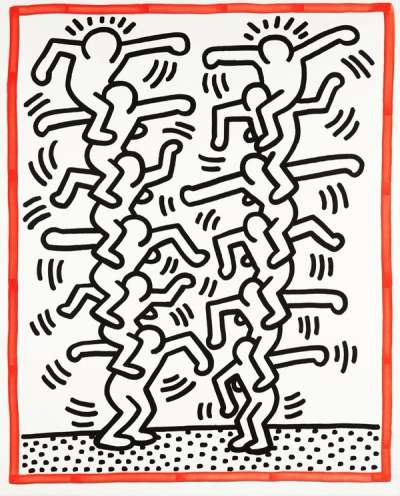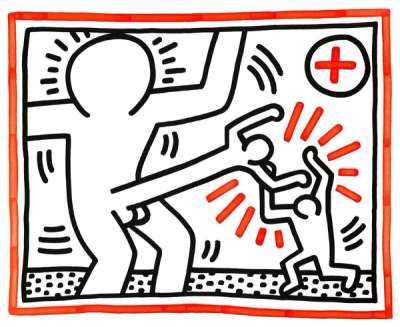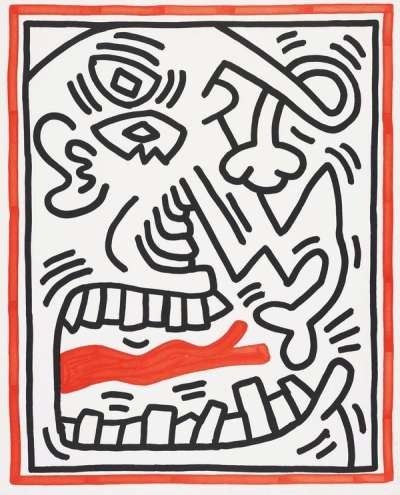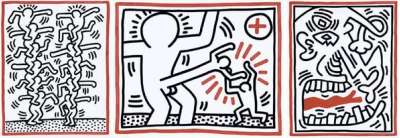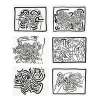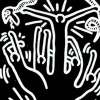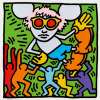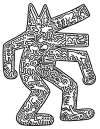Three
Lithographs
In his series Three Lithographs, Keith Haring explores themes related to sexuality and substance abuse through a style that mimics the simplicity of children’s book illustrations; in a limited palette of white, red and black. Unlike Haring's typical screen-printing process, these prints were made using the lithographic printing method.
Keith Haring Three Lithographs For sale
Three Lithographs Value (5 Years)
Works from the Three Lithographs series by Keith Haring have a strong market value presence, with 56 auction appearances. Top performing works have achieved standout auction results, with peak hammer prices of £66948. Over the past 12 months, average values across the series have ranged from £14518 to £66948. The series shows an average annual growth rate of 13.08%.
Three Lithographs Market value
Auction Results
| Artwork | Auction Date | Auction House | Return to Seller | Hammer Price | Buyer Paid |
|---|---|---|---|---|---|
 Three Lithographs 3 Keith Haring Signed Print | 26 Sept 2025 | Freeman's | £51,000 | £60,000 | £80,000 |
 Three Lithographs 2 Keith Haring Signed Print | 26 Sept 2025 | Freeman's | £11,475 | £13,500 | £18,000 |
 Three Lithographs 1 Keith Haring Signed Print | 20 Apr 2023 | Christie's New York | £10,625 | £12,500 | £17,000 |
Three Lithographs (complete set) Keith Haring Signed Print | 24 Jun 2022 | Ader | £38,250 | £45,000 | £70,000 |
Sell Your Art
with Us
with Us
Join Our Network of Collectors. Buy, Sell and Track Demand
Meaning & Analysis
Three Lithographs are typical examples of Haring’s beloved graphic, linear style, depicted here in only white, red and black. Created in a style that mimics children’s drawings, using bold, rounded lines and flattened colour, this series exemplifies a character that is entirely adult in tone, exploring ideas surrounding queer theory, desire and substance abuse.
Haring’s Three Lithographs series is produced through the lithographic printing process that utilises a slab of stone or metal to apply ink that then repels the pigment onto fibrous material like paper. Unlike Haring’s more commercial screen printing method, this printing process dates back to the 18th century and has the capacity to produce exceptional detail across hundreds of multiples. Haring’s use of lithography as a method of printing worked to maintain the crisp edges and opaque sections of colour that make up his signature style. Additionally, the Three Lithographs series retains a hand-painted quality characteristic of the lithography printing process, as most clearly seen in the red lines used in each print.
Showing images of sexually explicit stick figures, energetic bodies and a monstrous-looking face, this series exemplifies Haring’s pop art style that produces outrageous and comical compositions. Haring was clever in his ability to create works that act as social commentaries and at the same time prove appealing to a wide range of people, children and adults alike. This sardonic subject matter is performed through an energetic and positive visual language that translates well in the context of pop culture and media, successfully working to democratise art. In their outrageousness, the prints in the Three Lithographs series recall the exaggerated sensibility of camp that Haring used as a subversive tool.
Due to Haring’s use of bold, emanating lines, splashes of flattened red and dotted landscapes, the series is charged with high excitement and movement. It is ambiguous as to whether the figures are dancing or fighting in each image as Haring toes the line between light-hearted comedy and monstrous imagery in each print.
Three Lithographs 3 shows one of Haring’s most iconic motifs, the ‘People Ladder’, showing two sets of six figures stacked upon one another’s shoulders, both facing inwards in opposing directions. The ‘People Ladder’ in Haring’s work has come to represent a tower of break dancers stacked on top of one another to convey a sense of joy and community in a way that reflected the artist’s love of hip hop emerging in New York City in the 1980s. Haring’s use of action lines on either side of the towers and over the heads of the two top figures works to create a sense of excitement in the print and also signifies the figures’ struggle to balance.
The Three Lithographs series is a significant example of Haring’s simplistic visual language that works to communicate complex ideas around queerness and drug abuse. The artist’s lithographic works have proven to be extremely influential with his stick figures still being used in pop culture iconography today and many contemporary artists like KAWS have drawn huge inspiration from Haring’s prints.
